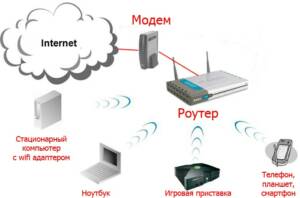What is the Internet and how does it work via cable?
The Internet is a global network that connects millions of computers around the world. It works through a cable that connects these computers to each other. Cable transmits information using various protocols such as TCP/IP, HTTP and FTP. Cable Internet is one of the most common methods of connecting to the Internet. It uses a cable line, usually coaxial cable or fiber optic cable, to connect your computer to your Internet service provider. The provider, in turn, is connected to the Internet. However, even when using cable Internet, connection problems may arise. The reasons may be different: problems on the provider’s side, problems with the cable itself, network settings and much more. To solve the problem of the Internet being lost through the cable, you must first determine the cause of the problem. If these are problems on the provider's side, then the problem can only be solved with the help of the provider. If the problem is related to the network settings, you can try changing the settings or seek help from a specialist. In any case, it is important to remember that connecting to the Internet is a complex process that requires certain knowledge and skills. If you are not confident in your abilities, it is better to seek help from a specialist. When the Internet disappears through a cable, it can be caused by several reasons. The problem may be with the cable itself, which may be damaged or not connected correctly. The network card or router may also malfunction. Another reason could be the presence of viruses or other malicious software on the computer. To solve a problem, you must first find out the cause. If the cable is damaged, it must be replaced or repaired. If the problem is related to a hardware malfunction, you can try rebooting the router or network card. If viruses or other malicious software are detected, you must install anti-virus software and conduct a full system scan.
Problems with the cable and connection to the computer
The quality of your Internet connection can depend on many factors, including the stability of the cable and whether it is properly connected to your computer. One of the main and most common problems is cable failure. A damaged or old cable can cause connection problems and loss of internet.
It's also worth paying attention to how you connect the cable to your computer. Incorrect cable installation can lead to malfunctions and reduced Internet speed. It is important to ensure that the cable is connected to the correct port on the computer and that there is no damage to the connectors.
If you are having problems with the cable and connection to your computer, there are several solutions. Firstly, you can try replacing the cable with a new, high-quality one. Secondly, check that the cable is connected correctly to the computer and router. If the problem persists, you need to contact a specialist who can diagnose and find the cause of the problem.
In any case, problems with the cable and connection to the computer can lead to serious problems with the use of the Internet. Therefore, it is important to monitor the condition of the cable and regularly check that it is connected correctly.
Problems with network device settings
One of the main reasons for the Internet loss via cable may be incorrect configuration of network devices. For example, an incorrectly configured router can result in loss of internet signal. Additionally, not all devices can be configured automatically, so you must manually verify that the settings are correct.
Another common problem is the failure of network drivers. Faulty drivers can cause you to lose your internet connection, so they need to be updated regularly. There may also be problems with cables, their ports or sockets, which may be damaged or faulty.
Solving problems with network device settings can be quite simple. First, you need to check your router settings and make sure that they meet the requirements of your provider. If this doesn't help, you can try updating network device drivers or replacing cables.
In general, problems with network device settings can be caused by various reasons. However, if you diagnose them correctly and take appropriate measures, you can quickly restore your Internet connection and continue to use the network without problems.
Malware and antivirus programs
One of the possible reasons for the Internet to disappear on a computer may be the presence of malware. Viruses, Trojan horses, and other types of malware can slow down your computer, change its settings, and block Internet access. To protect your computer from viruses and other threats, you need to install an antivirus program.
An antivirus program detects and removes viruses, Trojan horses, and other types of malware, and protects your computer from new threats. Some antivirus programs also provide protection against phishing attacks and block spam.
When choosing an antivirus program, you should pay attention to its effectiveness, ease of use and speed. Some antivirus programs can slow down your computer, so you should choose a program that will not greatly affect the performance of your device.
Problems with equipment and the need to replace it
Situations often arise when the Internet on the computer disappears through the cable. One reason could be faulty network equipment, including a cable, network card, router, or modem. In this case, replacing the equipment may solve the problem. The reason may also be outdated equipment that does not support new technologies and standards. In this case, a hardware update is also necessary. We should not forget about the correct configuration of network parameters on the computer and equipment, which is also important for stable operation of the Internet. How to properly maintain network equipment
Troubleshooting Internet connection problems may be due to faulty network equipment. Carrying out regular maintenance can help prevent such failures and reduce the risk of problems occurring.
Firstly, it is necessary to regularly update the firmware of the router, switch and other equipment. This will improve device performance, ensure security, and eliminate known vulnerabilities.
Second, you should check your network equipment settings, such as IP addresses, subnet masks, and default gateways. Incorrect settings can lead to connection problems, so it is important to check them regularly.
Thirdly, it is necessary to monitor the status of physical connections between devices. Loose or damaged cables can lead to signal loss and connection problems. It is recommended to use quality cables and check them if necessary.
Fourth, to improve network performance, you can use monitoring tools that allow you to monitor network load and identify bottlenecks. This will help you identify possible problems and take steps to eliminate them.
Fifthly, do not forget about backing up equipment configurations and network device settings. This will allow you to quickly restore network operation in the event of a failure or equipment failure.
Carrying out regular maintenance of your network equipment is an important step to ensure stable network operation and prevent Internet connection problems.
Read further:






